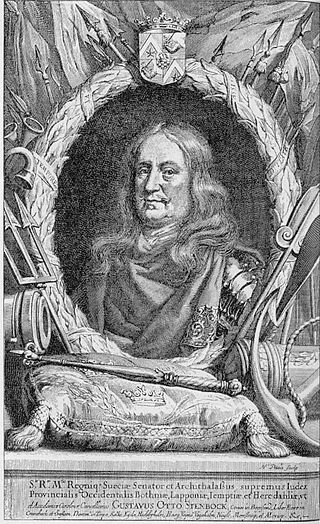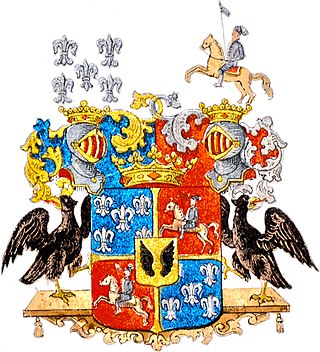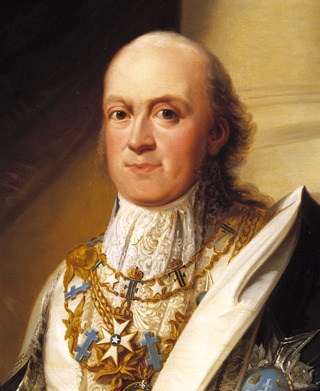Related Research Articles
The Council of the Realm, or simply The Council, was a cabinet of medieval origin, consisting of magnates which advised, and at times co-ruled with, the King of Sweden.

Gustaf Otto Gustafsson Stenbock was a Swedish military officer and politician.

The Swedish nobility has historically been a legally and/or socially privileged class in Sweden, and part of the so-called frälse. The archaic term for nobility, frälse, also included the clergy, a classification defined by tax exemptions and representation in the diet. Today the nobility does not maintain its former legal privileges although family names, titles and coats of arms are still protected. The Swedish nobility consists of both "introduced" and "unintroduced" nobility, where the latter has not been formally "introduced" at the House of Nobility (Riddarhuset). The House of Nobility still maintains a fee for male members over the age of 18 for upkeep on pertinent buildings in Stockholm.

The Governor of a province of Finland headed the activities of the State Provincial Office until the end of 2009, when the provinces were abolished. The governors were appointed by the President. Many former ministers including but not limited to Kaarlo Hillilä, Martti Miettunen, Hannele Pokka and Anneli Taina served as governors, since the post was regarded as prestigious enough for a retiring minister, but still politically neutral. The title of maaherra was also considered a personal title, such that once appointed, the title maaherra remained for life.
Lantmarskalk, was the title of one of the speakers of the Swedish Riksdag of the Estates, from 1627 to 1866 and of the Diet of Grand Duchy of Finland from 1809 to 1906. The Lantmarskalk was appointed by the Estate of the Nobles and also served as its speaker (talman). The Lantmarskalk should not be confused with the Riksmarsk or the Riksmarskalk, which were Great Officers of the Realm and royal appointees.

Brahe is the name of two closely related Scanian noble families who were influential in both Danish and Swedish history. The noble families became extinct in Denmark in 1786 and in Sweden in 1930.
The creation and granting of counties and baronies in Finland began with the coronation of King Eric XIV in 1561 and continued through Great Reductions in the latter half of the 17th century.

The Lord of the Realm was a title of honour introduced by Gustavus III, King of Sweden shortly after his coup and the newly passed constitution. The title was granted by the King and was first received by Frederick William, Prince von Hessenstein on 15 January 1773 by letter. One of the most famous title holders was Hans Axel, Count von Fersen, the supposed lover and confidant of Marie Antoinette, Queen of France.

Kulla Gunnarstorp Castle is a castle in Helsingborg Municipality, Scania, in southern Sweden. Kulla Gunnarstorp is located near the Öresund between the villages Hittarp and Domsten, about 10 kilometers north of Helsingborg.

Baron Fredrik von Essen was a Swedish politician, friherre, Marshal of the Realm and lord of Kavlås Castle.

Count Magnus Gabriel De la Gardie was a Swedish statesman and military man. He became a member of the Swedish Privy Council in 1647 and came to be the holder of three of the five offices counted as the Great Officers of the Realm, namely Lord High Treasurer, Lord High Chancellor and Lord High Steward. He also served as Governor-General in the Swedish dominion of Livonia.

The Wachtmeister family is a Swedish noble family from Livonia, who immigrated to Sweden in the 16th century. The name Wachtmeister is German for 'sergeant'.

Magnus Fredrik Brahe was a Swedish noble and courtier.
References
- ↑ Gullberg, Ingvar E. (1977). Svensk-engelsk fackordbok för näringsliv, förvaltning, undervisning och forskning [A Swedish-English dictionary of technical terms used in business, industry, administration, education and research] (in Swedish) (2nd ed.). Stockholm: Norstedt. p. 1559. ISBN 91-1-775052-0. SELIBR 8345587.
- ↑ url=https://www.riddarhuset.se/organisation/
- ↑ url=https://www.riddarhuset.se/direktion/